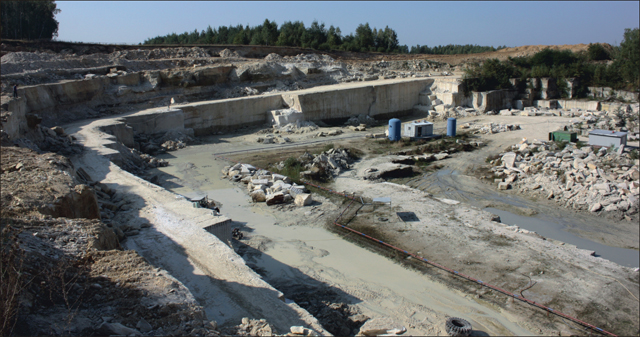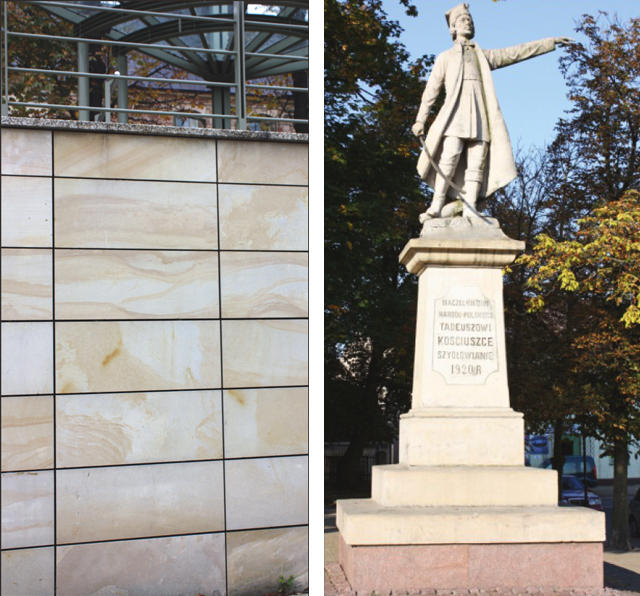JURRASIC SANDSTONES

Continuing our series devoted to the Świętokrzyskie stones, one cannot ignore the Jurassic sandstones occurring in several places of this region. Examples come, among others, from the vicinity of Szydłowiec and the vicinity of Żarnów. Local sandstone has long been a valued building material for the production of cladding, plinths, sculptures and aggregate. These days, they are becoming a popular resource again.
The sandstones of Szydłowiec
The name refers to sandstones exploited in the Szydłowiec region. Deposits of this raw material arose in the Jurassic period in an environment of shallow water reservoirs near the mainland or islands, at the mouths of slowly flowing, calm rivers – and they do, therefore, contain large amounts of plant debris.
They are white sandstones with a pale bluish shade, sometimes grayish-yellowish. They are fine-grained, with a weak silica and silica-clay binder. They are distinguished by exceptionally good separation and blockiness.
Structures made of this type of sandstone eventually acquire a gray patina layer which becomes harder over the time and protects against the harmful effects of weather conditions.
The exploitation of sandstone in this area began around the 15th century and has, with varying intensity, continued to the present. Initially, they were mainly grinders, millstones, querns, whetstones, baptismal fonts and a few architectural details used in local construction were made here. A great opportunity for the Szydłowiec deposits was the construction of a railway line connecting the Szydłowiec region with Warsaw in 1870 and the connection with Dąbrowa Górnicza built in 1885. This railway connection made it possible to deliver raw materials to Silesia, the capital and further to Western European countries as well as Russia. A golden age for the Szydłowiec sandstones began. Not only façade slabs, plinths, elements for retaining walls were made, but also sculptures, architectural details, ornaments, columns, balustrades, lanterns, portals, fountains and tombstones. The period of the greatest exploitation of this stone falls into the 1950s and 1960s, which was connected with the renewal of Polish cities after the war.

The sandstones of Żarnów
The village of Żarnów is situated in the southern part of the Opoczyńskie Hills, in the north-western part of the Świętokrzyski region. The deposits of yellow, dark pink and cherry, fine-grained sandstones occurring here were formed in the Lower Jurassic period. Currently, they are extracted from numerous open-pit mines located throughout the village. These sandstones are easy to work with – they are relatively soft when fresh, and only become harder with time.
The history of the exploitation of the Żarnów deposits dates back to the 12th century. Żarnów itself probably owes its name to querns (Polish żarna) – especially to those made of local sandstone. An interesting example of the use of local raw materials is the magnificent Romanesque church of St. Nicholas, which is said to have been built by Duke Bolesław III Wrymouth himself in 1111 as a votive gift in expressing gratitude for the victory of his troops over the Pomeranians. The church was built and later expanded using the local, regularly processed, fine-grained sandstone. The Żarnów sandstones were also used to build the Cistercian abbey of Sulejów.
At present, the raw material obtained from the quarries in the vicinity of Żarnów is used for the production of a full range of architectural details and facade panels, e.g. for the building of the Warsaw Stock Exchange. Thanks to reaching for deeper layers of sandstone, rock blocks of varied and interesting colours are obtained here.
It is also used to produce large amounts of the so-called “wild stone”, i.e. irregular stone slabs made of split material.

Source: Kurier kamieniarski
Author: Jerzy Jędrychowski | Published: 23 December 2017
